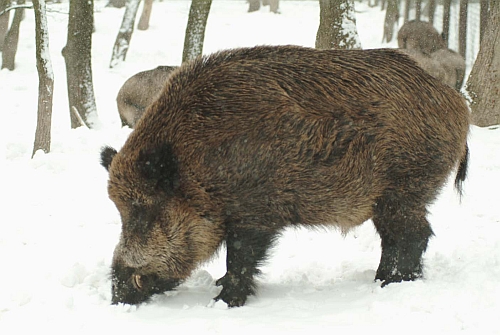Conservation activities
Habitat restoration
During habitat restoration the elimination of area fregmentation, the elimination of invasive species and restructuring of the wood present the biggest challenges.
The shrinking of the once cohesive woods, the settlement of alien species and the reorganised tree population present a serious threat for the long term survival of the wildlife of the area. Our aim is to restore the integrity of the woods, along with its species content and structure characteristics. We can thus ensure an easier and less risky wandering for numerous indigenous species of flora and fauna, increase the number of habitats appropriate for settlement and improve their quality.
We use several methods in order to solve our tasks. By planting new trees we will replace the alien species and the fragmentation of the wood will decrease. We will eliminate the alien species from the areas having a more natural status but presently infected, and if necessary supplement the wood with young trees of indigenous species.
The Duna-Ipoly National Park Directorate takes over the restricted right of disposal from the forest owners for 90 years. The owners get compensation for the loss of income caused by the suspension of logging. In the future only nature conservation management activities can be carried out in the forest. The allocation of the forests changes from 'forests for wood production' category (economic purposes) to 'forests for soil protection' category, according to which there is no reforestation obligation until 30% of foliage closure. This possibility is really important for shaping and sustaining the natural structure of the steppe oak woods. We apply methods based on natural processes where structure reshaping is needed.
Game exclusion experiment
We build fences to exclude large game animals from some parts of the area in order to enhance the regeneration of the oak woods.
 The excessive game population can significantly obstruct natural forest regeneration processes. Fallow Deer and Roe Deer pick the offshoot of young trees, Wild Boars dig out most of the acorns buried in the ground; thus the offspring is not able to grow and provide a supply for the natural forest regeneration processes. Before the time of drastic human intervention the size of the game population was regulated by large carnivores (wolf, lynx, bear in some places). With the extinction of the large carnivores the game population can only be controlled in a given area by exclusion or hunting of the large game animals. The excessive game population can significantly obstruct natural forest regeneration processes. Fallow Deer and Roe Deer pick the offshoot of young trees, Wild Boars dig out most of the acorns buried in the ground; thus the offspring is not able to grow and provide a supply for the natural forest regeneration processes. Before the time of drastic human intervention the size of the game population was regulated by large carnivores (wolf, lynx, bear in some places). With the extinction of the large carnivores the game population can only be controlled in a given area by exclusion or hunting of the large game animals.
According to some opinions instead of (or besides) the excessive game population the decrease of the ground water level causes the disappearance of natural forest regeneration processes. In order to assess the affects of the two factors and to decide the question a field experiment is needed – for this purpose an almost 12 km long game exclusion fence will be built. 170 acres of the wood will be surrounded with the fence, from where we exclude the game by capturing and driving out the large game animals. At present we plan the fence for the next 20-25 years.
We will assess our future activities based on the results of the exclusion fence experiment. In case oak regeneration processes are good within the fence, a suggestion should be made towards the decrease of the game population. In case the oak regeneration processes are not successful within the fence either, we have to take into consideration the natural restructuration of the habitat, as a result of which the territory of sand steppes will increase. In this case the oak woods can be settled or let be formed by natural conditions in different areas with more water supply.
Monitoring
During the monitoring process we can keep track of the effects of our management activities on the habitats and the changes in the biological status of habitats.
Monitoring means that we regularly keep track of the changes of the analysed area or the behaviour of the specimens of a species in a long term. At present two monitoring processes are conducted.
The aim of nature conservation management monitoring is to assess the effects of exclusion of invasive species, large game animals and reshaping of the wood structure.
The assessment starts with sampling. We assess the change of alternates suitable for the examination of management effeciency in 10x10 m large sampling squares (the so called quadrates). Such alternates are the species of plants and trees in the understorey, their health status, size, etc. The first step of monitoring is the recording of the basic status, when we record the status preceding the management processes. We conduct monitoring two times a year, in the beginning and in the end of summer. For keeping track of the effects of game exclusion we assign sampling squares within and outside the fence for reference.
Biodiversity monitoring of a habitat shows the indirect effects of management, by examining many groups of species together. Examination of dead wood samples for symbiontic associations is also conducted as a supplementary examination, with the analysis of 5 indigenous and 5 alien tree trunks per year. The survey is conducted every year until 31 August, in the most appropriate time for the examined species.
Evaluation of the results will take place in the last year of the project in 2011.
|